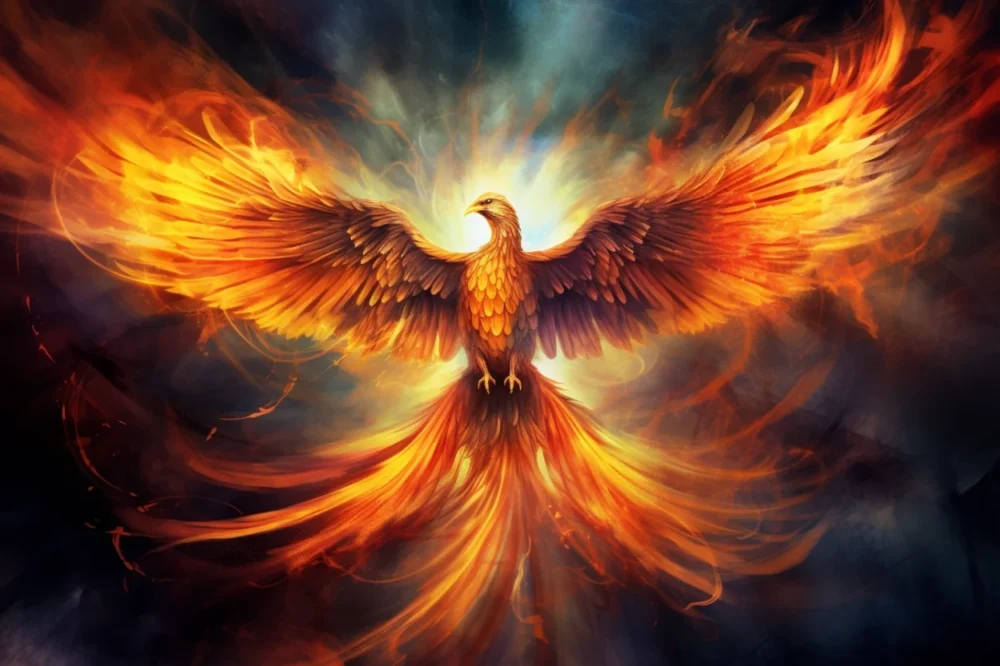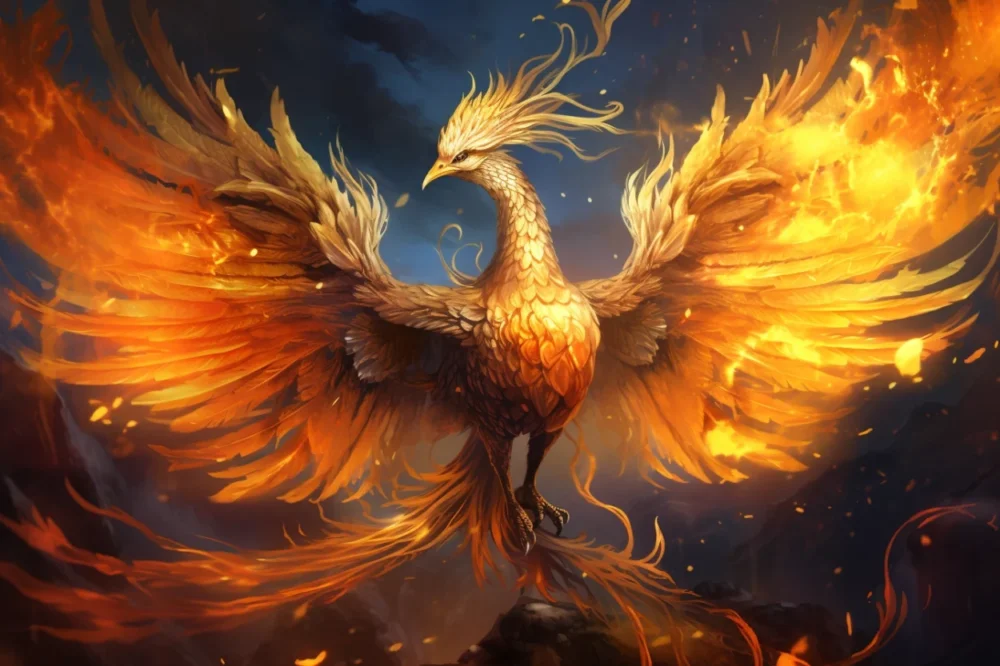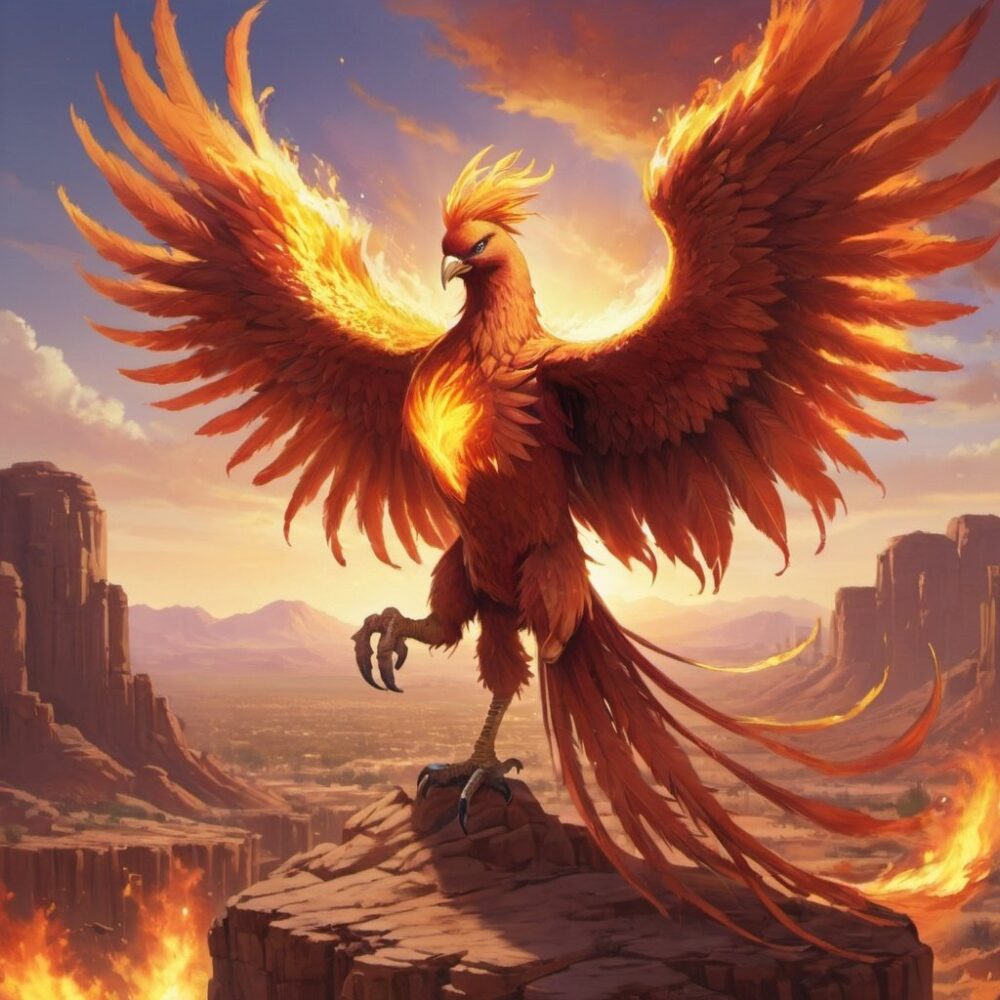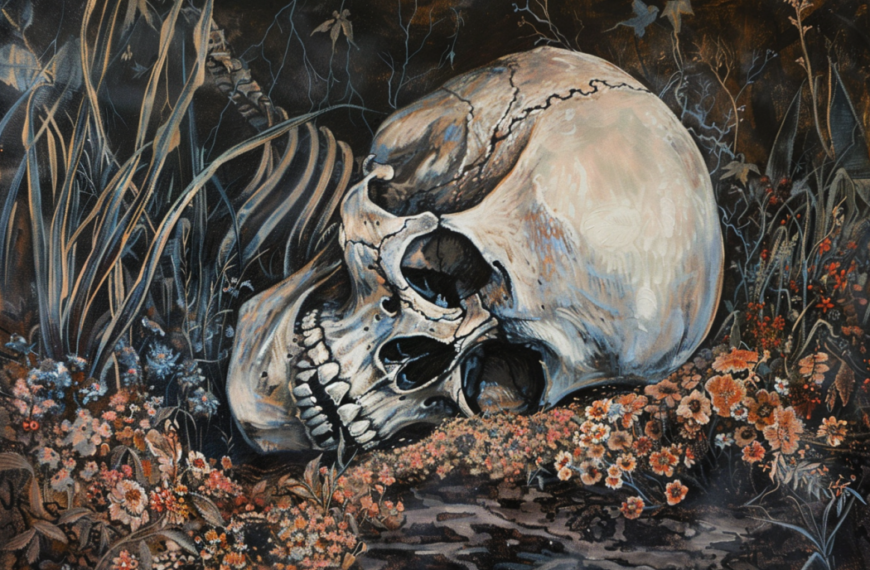Phoenix Symbolism & Meaning: Ultimate Guide
The phoenix symbolism is all about resurrection, immortality, transformation, hope, majesty, and libration. Sharing the same origin myth from the East to the West, the phoenix is a fascinating creature that has captured the interest of people around the world. In this article, we’ll explore the phoenix symbolism across cultures as well as their importance in art and literature around the world.
Phoenix Myth
Legend has it that once the Sun God looked down upon the Earth and saw a large bird soaring through the sky. This bird had smooth, shiny red feathers that emitted beautiful rays of golden light. The Sun God was mesmerized and granted the bird immortality. The Phoenix, overjoyed by this, circled around and flew straight toward the Sun God, saying, “I will dedicate my clear and melodious song to you, as a token of gratitude for the gift you have bestowed upon me.”
As time passed, the immortal life of the Phoenix became mundane. It was pursued by humans who desired its exquisite feathers. Tired of running from them, the Phoenix flew in the direction of the rising sun, seeking the distant East. One day, as the Phoenix flew over a scorching desert (present-day Western Asia), a place where no humans dwelled, it once again found freedom without the need to flee. It sang its clear song, delighting the Sun God.
Read More: Top Symbols of Freedom Across Culture
The Phoenix lived there, remaining immortal for 500 years, but it aged. Its song was no longer as clear, and it could no longer soar as high as before. Feeble and weak, it pleaded with the Sun God, saying, “Oh, Sun God, can you hear me? Grant me strength and restore my youthfulness as it once was.”
However, no matter how much it called out, the Phoenix received no response from the Sun God. Feeling despondent, it flew back to its old home, a place filled with memories of its youth. On the way back, the Phoenix would land in places with cinnamon bark and collect scattered dry leaves. Finally, the Phoenix perched on a tall palm tree. Using the dry cinnamon bark and leaves, it fashioned them into a nest.

Then, it searched for fragrant resin on the tree trunk and shaped them into egg-like fruits, placing them in the nest. The Phoenix lay on the nest, singing its song to call the Sun God, saying, “Sun God, can you hear me? Grant me strength and restore my youthfulness as it once was.”
This time, the Sun God heard its voice. The Sun God looked down upon the Earth and on the highest mountain peak, a palm tree sprouted. There, lying on the tree, was the beloved Phoenix, displaying its shiny feathers to bask in the rays of light bestowed upon it by the Sun God. At that moment, a magical phenomenon occurred. After a blinding flash, the entire body of the Phoenix transformed into a circle of fire, glowing red and illuminating the entire sky. The flames gradually extinguished, and the Phoenix disappeared into thin air.
After the flames extinguished, the Phoenix disappeared, leaving behind a pile of ashes that fell onto the nest. The ashes rolled together and gradually formed the shape of a small bird, which grew larger and larger until it took on the form of the Phoenix once again. The Phoenix was reborn in this way.
Read more: Feather Symbolism & Meaning: Ultimate Guide
Phoenix Symbolism Around The World

In some Western mythology, the Phoenix is considered a sacred and mystical firebird. The Greeks view it as the symbol of the sun god Apollo, representing immortality, the light of intellect, and powerful regeneration. In Egyptian mythology, it is seen as a bird similar to the heron or egret. The ancient Egyptians regarded it as a symbol of divinity and worshipped it with great reverence in Heliopolis. In Hinduism, the Phoenix is seen as the godly bird mentioned in the sacred Vedas.
Immortality
Overall, the symbol of the Phoenix in Western culture signifies rebirth, as you can see through the story above. Its tears have the power to heal wounds, both deep and superficial. Moreover, this bird possesses a melodious song that serves as a spiritual remedy for all. Its blood and flesh are believed to grant immortality, while its feathers act as protective talismans against evil forces.

Transformation
Rebirth is itself a profound form of transformation where something undergoes a magnificent process of renewal after a period of decline, destruction, or apparent death. It is a powerful shift, often associated with personal growth, spiritual awakening, and a fresh start in the infinite cycle of life and death.

The myth of the Phoenix does not end when it is reborn. When the Phoenix is reborn, it broke open the egg it had made from the fragrant resin and placed the remaining ashes on the nest inside the egg, sealing it. It took flight into the sky and let out a resounding song. As the Phoenix sang, the sky suddenly turned blue, trees and plants burst forth with fresh growth, a cool breeze blew through, and the weather became incredibly pleasant. All creatures ran out of their hiding places, eager to merge into the sunlight and sing along. The Phoenix has the power to transform not only itself but also the entire world where it inhabits.
The king of birds then soared upwards, heading towards the East and the desert region. Nowadays, it is believed that the Phoenix resides in the East. Every 500 years, it grows old and weak, returning to the West, where there are tall palm trees and the highest mountain, to build a nest using cinnamon bark and lay an egg made of fragrant resin. In this way, the Sun God will help it be reborn.
This legend has existed for thousands of years, originating from the beliefs of ancient Romans. It is the miraculous nature of immortality and rebirth that has made the Phoenix Firebird an enduring symbol throughout the historical and cultural heritage, from West to East.
The phoenix’s fiery demise and subsequent rebirth symbolize the cyclical nature of life and the overcoming of challenges. Out of destruction, there can always be creation, and from endings, there can arise fresh opportunities. The phoenix teaches us that even in the face of adversity or setbacks, we have the capacity to rise again, stronger and wiser.
Read more: 30 Symbols of Death & Their Meaning
Phoenix Symbolism As The Creator of the Universe
Phoenix is a bird of great virtue and high reverence. According to the mythology of the East, after the deity Pan Gu emerged from the colossal “egg” of chaos, four other creatures came into existence alongside him. They were the Dragon, the Unicorn, the Tortoise, and the Phoenix.

These are known as the Four Divine Beasts, which joined forces with Pan Gu to create the world. They used their divine powers to establish the Five Elements (metal, wood, water, fire, earth), the four seasons (spring, summer, autumn, winter), and the four cardinal directions (east, west, south, north). In the process of world creation, the Phoenix took charge of fire, the summer season, and the southern direction.
In a way, the Phoenix was already there when the Universe was born, and it witnessed how the world changes over millions of years.
Royalty
The Chinese historical records state that King Fu Hi once witnessed the Phoenix. According to ancient dictionaries from the Qing Dynasty, the Phoenix is not just a “legend,” but a real creature that dwells in extremely high and remote mountain ranges, making it difficult for humans to see. In East Asian religions, the Phoenix is regarded as a symbol of grace and faith, as well as a majestic creature of authority, similar to the Dragon. Chinese emperors placed images of the Phoenix in palaces or embroidered it on imperial robes, symbolizing victory and imperial power.

The Phoenix is also a creature of grace. The Eastern culture has depicted the Phoenix as a bird that combines the most beautiful features of various species, such as the beauty of a rooster’s head, the tall neck of a crane, the sleek and shimmering tail of a peacock, the beak of a falcon, the feathers of a partridge, the scales of a carp, and the talons of an eagle. Each part of its body carries its own symbolic meaning.
The Phoenix bestows blessings upon those fortunate enough to encounter them and heralds special events. For example, seeing a phoenix when an emperor is born signifies that the child will grow up to be a virtuous and benevolent ruler—the greatest blessing for a nation. Throughout history, the phoenix has also heralded the appearance of great philosophers, indicating the presence of ethics and stability.
Virtues

Phoenix represents great virtues that all upstanding citizens should strive to achieve. The colorful plumage of the Phoenix consists of five fundamental colors in Eastern philosophy: yellow, white, red, black, and green; corresponding to the five values of Confucianism: benevolence, righteousness, propriety, wisdom, and faith. The fiery Phoenix in Eastern culture is a powerful inspiration that honors traditional values. The Phoenix connects the universe, nature, and humanity with the principles of traditional ethics, becoming an eternal symbol of beauty, grace, virtue, and sacredness.
Connection With Divinity
The Phoenix was there when the Universe was formed. Some legends describe the body of the Phoenix as corresponding to celestial bodies, with its head as the sky, its eyes as the sun, its back as the moon, its feet as the earth, and its tail as the planets. Therefore, the Phoenix is considered the link between the human world and the Divine. The physical form of the Phoenix symbolizes the five virtues of humanity: the head symbolizes righteousness, the wings symbolize the spirit of responsibility and duty, the back symbolizes skillful interpersonal relations, the chest represents compassion and hidden wisdom, and the abdomen signifies reliability.
From ancient times to the present, the image of the Phoenix often appears as a pair, with a male bird called “Feng” and a female bird called “huang.” They symbolize the harmonious union of yin and yang and represent the relationship between male and female.
Phoenix Symbolism In Egyptian Mythology
Bennu is an ancient Egyptian deity associated with the Sun, creation, and rebirth. Although its appearance closely resembles a heron, Bennu is still believed to have been the original inspiration for the phoenix legends found in Greek mythology and Chinese mythology. However, the true origin of the Phoenix was still in dispute.

Bennu also played a significant role in the creation of the world. It was considered to be the ba of Ra (i.e. a part among many parts of the soul of Ra – the sun god), and facilitated the creative actions of Atum. Bennu symbolized rebirth and was closely associated with Osiris, the god of the afterlife. The deity held titles such as “He Who Came Into Being by Himself” and “Lord of Jubilees,” referring to its periodic renewal akin to the sun’s cycle. The name Bennu itself derives from the Egyptian verb “wbn,” meaning “to rise in brilliance” or “to shine.”
Bennu is sometimes depicted perched on a benben stone, representing Ra, or in a willow tree, symbolizing Osiris. During the New Kingdom, Bennu was occasionally depicted wearing the Atef crown, a symbol associated with Osiris. The portrayal of Bennu in Egyptian artwork varied over time, but its connection with the concepts of creation, rebirth, and the divine made it an important deity in the ancient Egyptian religious pantheon.
Phoenix Symbolism In Hinduism

There is also a version of the Phoenix in Hinduism – Garuda – a majestic bird resembling an eagle and revered as the ruler of all birds. The Rigveda mentions a celestial deity called Garutman, described as having wings. The Yajurveda’s Shatapatha Brahmana further identifies Garuda as a symbolic representation of bravery.
In the epic Mahabharata, Garutman is equated with Garuda and characterized as incredibly swift, capable of assuming various forms and infiltrating any location. This formidable creature possesses immense power, capable of stopping the rotation of heaven, earth, and the underworld with the flapping of its wings. Garuda is recognized as the sacred mount of the Hindu deity Vishnu, often depicted alongside him. Additionally, Garuda is the younger sibling of Aruna, who serves as the charioteer of the sun god.
Phoenix In Slavic Folklore
In Slavic folklore, the Phoenix is simply called the Firebird. The Firebird is a large bird with stunning feathers that emit a vibrant glow in red, orange, and yellow hues, resembling the calming flames of a bonfire. Interestingly, these feathers retain their luminosity even when detached, and just a single feather has the potential to illuminate an entire room if not concealed. However, it is important to note that despite its captivating beauty, the Firebird does not exhibit any signs of friendliness. Instead, it exudes an air of danger and caution.
The myth of the Phoenix is slightly different from other versions around the world. In this version, Maryushka, a humble orphan in a small village, captivates people near and far with her exquisite embroidery. Merchants eagerly seek to recruit her talents, but Maryushka says that she only sell her work only to those who truly appreciate its beauty.
One day, the evil sorcerer Kaschei, envious of her skills, disguises himself as a handsome man and tempts her with the promise of queenship if she embroiders exclusively for him. Unswayed, Maryushka refuses, choosing to stay in her village. Enraged, Kaschei transforms Maryushka into a Firebird and himself into a black Falcon, snatching her away. As she departs, Maryushka scatters her magical rainbow feathers as a lasting reminder for her village, their vibrant hues revealed only to those who value beauty and seek to create it for others.
Phoenix Symbolism In Persian Mythology

The Simurgh is a mythical bird in Persian mythology and literature. It is often associated with other mythological birds like the phoenix and the humā, but still have distinctive aspects that make it stand out.
According to Iranian legends, the Simurgh is incredibly ancient, having witnessed the world’s destruction three times over. Its long lifespan has endowed it with extensive knowledge spanning all ages. In one tale, the Simurgh is said to have lived for 1,700 years before immolating itself in flames, much like the phoenix. The simurgh was believed to bring fertility to the land and waters, acting as a mediator between the Earth and the sky. It is similar to the divine aspect of the Phoenix symbolism.
The Simurgh resided in Gaokerena, the Hōm Tree of Life, situated in the center of the world sea (Vourukasha). This tree possessed powerful healing properties and was known as the source of all-healing medicine, containing the seeds of every plant. When the simurgh took flight, the leaves of the tree would shake, causing the seeds to scatter across the world. These seeds would then sprout and grow into various plants, providing cures for all human ailments.







